About Opals
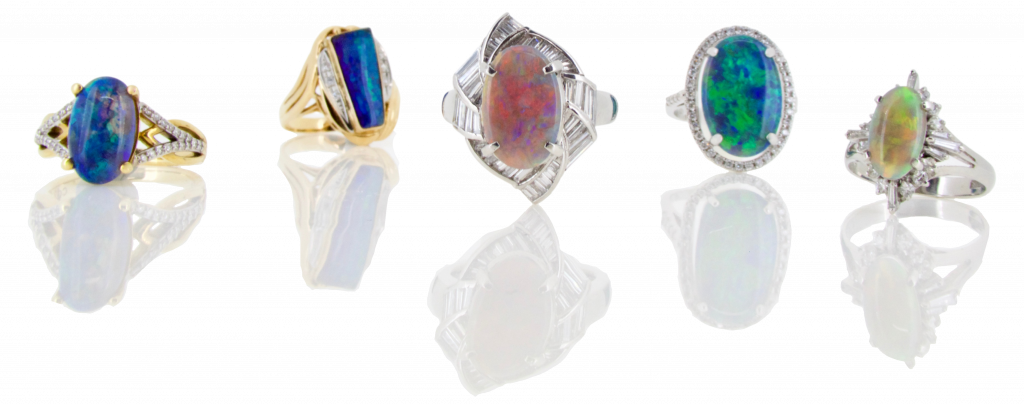
Opal is classified as a precious gemstone. It is a formation of non-crystalline silica gel. Millions of years ago, this silica gel seeped into crevices and cracks of the earth’s sedimentary strata. Through eons of time and through nature’s heating and moulding processes, the gel hardened and can today be found in the form of brilliant opal.
Opal contains about six to 10 per cent water and consists of small silica spheres arranged in a regular pattern. Colour is caused by the regular array of the silica spheres diffracting white light and breaking it up into the colours of the spectrum. The diameter and spacing of the spheres, controls the colour range. In potch opal, which displays no colour, the silica spheres may be absent or too small or arranged irregularly to produce colour.
Generally, opal measures 5.5 to 6.5 on MOH’s hardness scale with diamonds measuring 9 to 10 and pearls 4 to 5. Opal is recognised as the birthstone for October.
Types Of Opal
Australia has a great wealth of opals still hidden in the more remote and forbidding parts of the continent. Unlike many other gemstones, opal does not occur in lengthy veins or in diamond-like concentrations. Small clusters of gem-quality material may be scattered over an area scores of miles in each direction; luck seems the principal reason they are found at all.
Opal is found in many varieties, but precious opal represents a remarkably small percentage of the total opal mined. Fine gem quality opal is rarer than rubies and emeralds. It is a more natural gem, and is a thing of beauty and obvious worth, even in its natural state.
Black Opal
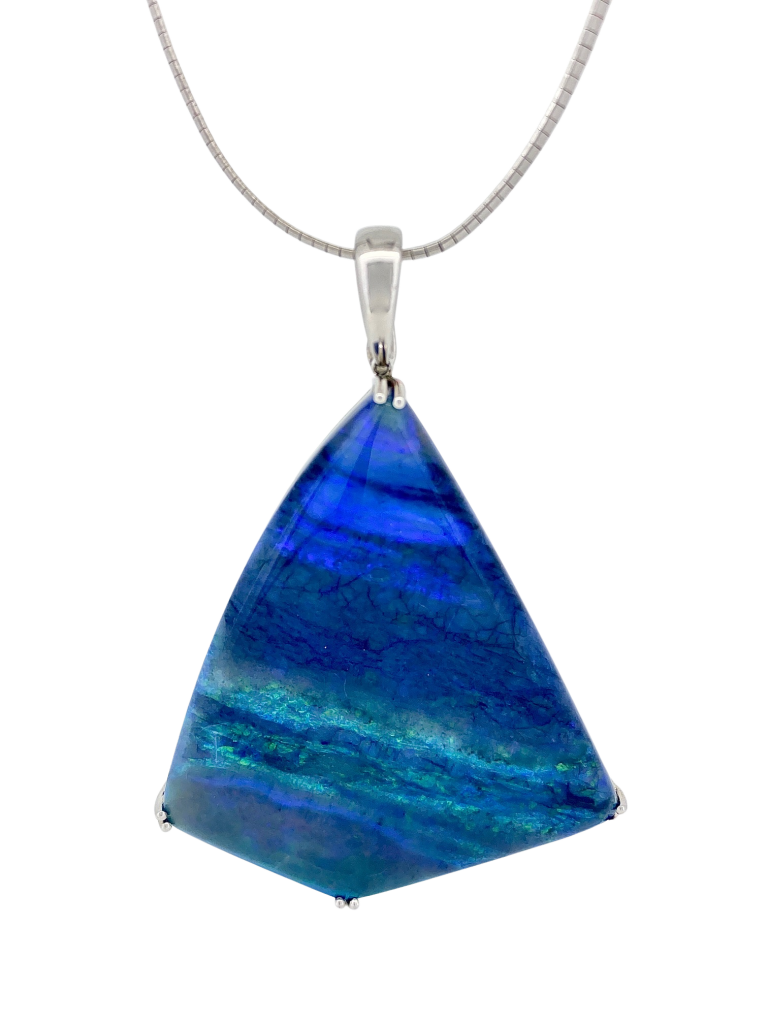
Black opal is the rarest and valuable of all opal. It is solid and generally found as a bar (or bars) of various colours in a dark body (black, blue, brown, or grey). Some black opals have a complete rainbow of colours while others have deep blue-green hues.
In addition, there are also semi-black opals and black crystal opals. While a true black opal displays sharp brilliant colours on a dark background, the semi-black opal shows a background or body colour of mid-grey. In contrast, the black crystal opal is translucent with no traces of black potch on its underside. Its colours are sharp and visible beneath the surface.
Few realise that 99.9 percent of the world’s supply of this radiant gem is mined at only three pinpoints on the globe: Lightning Ridge, Mintabie, and Andamooka. The majority of opal found at Mintabie and Andamooka is classified as semi- black opal.
Boulder Opal
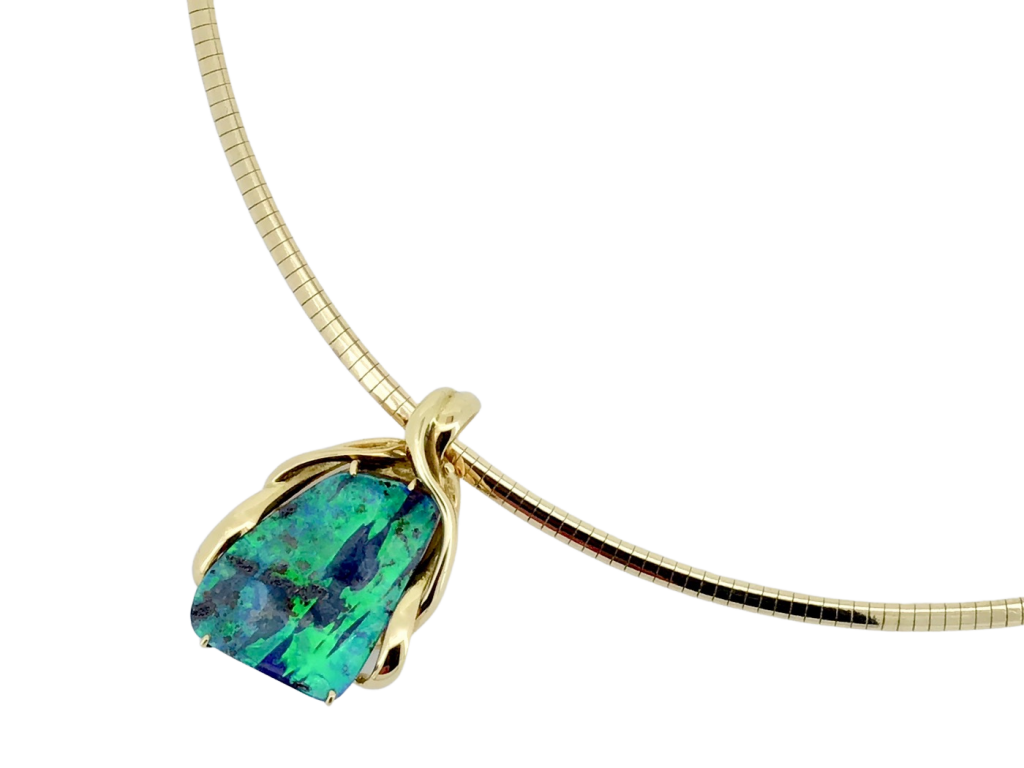
Boulder opal is also classified as solid opal. It occurs as thin veins of precious opal in the cracks and cavities of light and dark brown ironstone boulders in Queensland. The opal flowed into the cracks and fissures in the boulders in liquid form millions of years ago. With the passing of centuries, the liquid material formed into solid opal and now miners cut these stones into magnificent pieces with the natural host rock left on the back.
Boulder opal can be found in many different forms and colours: its surface can be smooth or uneven, with the opal occurring as a solid piece on top of the ironstone or showing as flashing flecks of colour throughout the ironstone (known as matrix opal). There are also the famous nut opals, known as ‘Yowah-nuts’ and unique to Queensland. These smaller ironstone concretions up to 5cm across may host a kernel of solid opal or contain a network of thin veins of opal through the ironstone. The best development of this variety of opal is at Yowah, hence the name ‘Yowah-nuts’.
Boulder opals are fashioned to standard shapes and sizes but are mostly cut in freeform shapes to highlight their individual beauty and to avoid unnecessary wastage.
Light Opal

Light opal is also classified as solid opal. Coober Pedy, Andamooka, and Mintabie in South Australia are the most productive mines for light opal.
A full range of colours swirls and flashes in the depths of a light opal. The background colour may be white or light blue. Light crystal opal is translucent and shows colours sharp and visible below the surface. When clear and colourless, this form is referred to as ‘water’ or ‘jelly’ opal.
More recently, Mintabie has discovered the more vibrant semi-black opal, which is tremendously popular for its beauty, and not as expensive as black opal. Light opal has a lighter background while semi-black opal has grey colour tones.
Doublet Opal
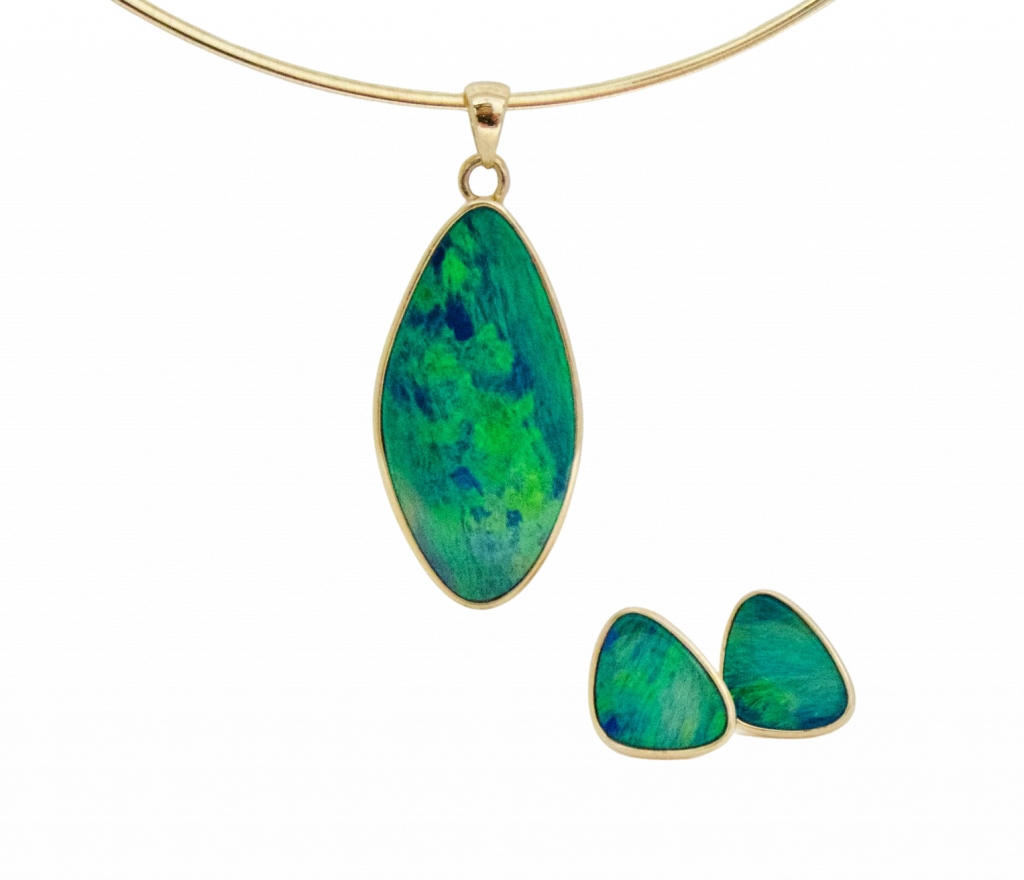
A doublet opal is not a solid opal: doublets are made of thin slices of fine quality opal (generally light opal) glued to a backing piece of black potch, glass or Queensland ironstone, thus resembling natural black opal or Queensland boulder opal.
Triplet Opal
A triplet opal is not a solid opal: triplets are made of three pieces, rather like a sandwich. Firstly, a flat thin slice of precious opal is glued onto a backing of common opal, glass, or porcelain that has first been darkened. A protective dome of a clear quartz crystal is then cemented to the precious opal with a clear resin (glue) to complete the triplet opal. A doublet opal is more valuable than a triplet because it has greater opal content.
Common Opal
‘Common opal’ is classified as non-gem quality opal. There are several varieties of common opal; most are opaque, and none exhibit any ‘play of colour’.
‘Hyalite’, or ‘Mullers Glass’, is a colourless opal that gives the appearance of glass. Rarely, it does display a faint tint of colour (blue, green, or yellow).
‘Hydrophane’ is an opaque porous opal that becomes transparent when immersed in water.
‘Resin opal’ is black or brown with a resinous lustre.
‘Potch’ is generally opaque and can be milky white, pale to dark grey, bluish-grey, or black. ‘Magpie potch’ is made up of black and white patches. A clear amber variety of potch has been found at Lightning Ridge.
Opalised Fossils
The Australian opal fields were at one time under the sea, so opalised fossils are occasionally unearthed. As the ages passed and the seas began to recede, millions of sea creatures were isolated and marooned. Eventually, the area dried completely and the inland is now a dry desert country.
In time the groundwaters, holding silica solution, also evaporated. They left behind the phenomenon known as ‘opal’. Hydrated silica was deposited in fissures in sandstone or gypsum and on jasper. It entered the shells of the stranded marine creatures. In some cases, it even replaced the entire shell.
One can find opalised wood, prehistoric animal bones, sea creatures, full seashells, skin shells, sponges, fish skeletons, and even opalised stems of plants on the opal fields.
Synthetic Opal
Synthetic opal is produced in the laboratory and has a similar structure to that of precious opal. The following observations can be made to differentiate between natural and synthetic opal:
Synthetic stones show brighter colours, and larger colour patches than natural opal. In synthetic opal, colour grain boundaries are highly irregular.
Synthetic opal has a distinctive snakeskin pattern.
Synthetic material shows a more ordered array of colours because the intricate pattern of natural opal cannot be duplicated.
Imitation Opal
This is non-opaline material such as coloured tinsel set in clear plastic or epoxy resin.
OPAL FIELDS IN AUSTRALIA
Lightning Ridge, NSW
This is a town famous for its rich, rare and glorious black opal. Black opal derives its name from the colour of the ‘nobbies’ or pieces of rough opal in which the gems are usually found. Lightning Ridge is located 770 kilometres northwest of Sydney in an area that also produces wheat, sheep, cattle and oilseeds.
Black opal was first discovered at Lighting Ridge in the late 1880s however, its commercial value was not at first recognised by buyers. Mining actually commenced in the early 1900s when some opal nobbies were found and trial shafts erected.
Opal occurs at Lightning Ridge either as ‘nobbies’, or in seams and thin layers within vertical or horizontal joint plains, in a soft greyish claystone that hardens and whitens on drying. This claystone is commonly referred to as ‘opal dirt’. The opal dirt levels occur between 6 and 18 metres from the surface but have been known to go as deep as 30 metres.
The fields also yield opalised shells, wood, and reptilian bones of the Cretaceous age.
Some of the traditional fields around Lightning Ridge include the Three Mile and Thorleys Six Mile however, most opal is now being found in newer areas away from the township.
White Cliffs, NSW
White Cliffs is Australia’s oldest commercial opal field. It is located 295 kilometres northeast of Broken Hill. Opal was first mined at White Cliffs about 1889, and the population peaked at 5,000 in its heyday despite the water shortages. Digging was very easy, and the light opal was very clean and found a ready market in Europe. The light crystal opal found at White Cliffs quickly became famous on the world markets.
For 30 years the White Cliff opal fields produced the first commercially accepted opal on the world markets, far surpassing the quality of the Hungarian opal. Opal displaying such vivid colours had never been seen before. The colourful seam opal was very easy to value, and it did not shatter like other opal when cut and polished.
From 1903 to 1914, the richer areas of the opal field became exhausted thus resulting in a decline in production. White Cliffs suffered and never recovered from the effects of World War I and the loss of the European markets. Today, White Cliffs is a unique town and very popular with the tourists, fossickers and miners. The modern age has brought electricity to the town and water is readily available. Some of the townspeople still prefer to live underground where it is cool in summer and warm in winter.
Although there is not much new ground left on the old opal field to sink a shaft, one can fossick among the old diggings. There are those who say that more opal than the amount mined remains in the ground ready for discovery: a new lucky strike will one day turn White Cliffs into a boom town again!
Central Queensland
The history of opal in Queensland dates back to the early 1870s, but it wasn’t until 1889 when the gem was successfully marketed that the industry became established. The discovery of opal was reported in many areas however, the real development of Queensland’s vast opal deposits began in 1873 with the discovery of fine quality opal north of Thargomindah. Within two years there had been many exciting finds throughout south western Queensland however, during those early years production was low because there was no ready market for the gem. It took the tireless efforts and sheer determination of a young entrepreneur named Tully Wollaston to convince world gem merchants to accept Queensland opal that the industry was finally established.
Today, the Queensland opal belt covers an extensive area in the southwest of the state that is around 1000 kilometres long by 300 kilometres wide. There are local areas throughout the region where opal mines are concentrated, such as Yowah, Quilpie, Eromanga and Jundah.
Coober Pedy, SA
Coober Pedy was discovered in 1915. This is where the ‘white’ or ‘milky’ opals (generally known as ‘light opal’) are mined. Until recently, Coober Pedy was the main producer of precious opal, which is why it is predominantly seen in stores overseas, particularly in the USA.
Today, the opal fields encompass an area of approximately 45 kilometres. The opal level is formed of soft pinkish clay mixed with soft bleached sandstone.
The name Coober Pedy is derived from the Aboriginal word kupa piti, which when loosely translated means “White Man in a Hole”. An isolated and rugged location, Coober Pedy is blessed with freezing nights, days where the average temperature seldom drops below 40¡C, and bush flies by the million. Coober Pedy is too hot for life to exist comfortably on the surface, so homes were made in underground burrows, which gave the field its name. Virtual palaces have been built underground, providing a constant temperature of between 21°C and 26°C.
Mintabie, SA
It is believed that Aborigines were the first to sell black opal from Mintabie at Coober Pedy just after the First World War. They were able to keep their secret for some time until eager miners discovered the opal field in the early 1930s. As a result of the remoteness of the area and the lack of water, Mintabie was worked only on a very small scale until 1976, when heavy earth-moving machinery moved in. The opal is sandwiched
between hard layers of sandstone, and the rock layers below the ground are drilled or blasted through with explosives to enable the bulldozers to get to the opal bearing ground.
This area is now producing very attractive light and semi-black opal. Mintabie black opal usually occurs on a mid-grey background therefore, although respected in the black opal markets, commands a lower price than the darker Lightning Ridge black opal.
Andamooka, SA
Andamooka is found southwest of Coober Pedy in harsh desert country. Discovered in 1930, Andamooka is one of Australia’s most famous opal fields, having produced some of the most beautiful pieces of opal.
Andamooka is derived from an Aboriginal name, meaning ‘Large Waterhole’. It is located 600 kilometres north of Adelaide and is the only Australian town where none of the streets is named.
The opal fields in and around Andamooka produce top gem, crystal, light opal and some dark opal.
Australia is the world’s greatest producer of precious opal. Over 90 per cent of the world’s commercial opal comes from the desolate outback. All of the significant opal deposits in Australia are located within the Great Artesian Basin or close to it. The places where opal has been mined over the past 100 years are located here. The most important deposits are found in New South Wales, South Australia and Queensland.
Today, the mining is carried out at the following main areas and each produce solid opal with specific characteristics and colour patterns.
VALUING OPAL
The type, colour, size and soundness of precious opal are factors that determine the price paid for the gemstone. The price is based on the quality of the opal and expressed per carat. Furthermore, there is a marked difference between the value of uncut opal compared with the value of cut and polished opal.
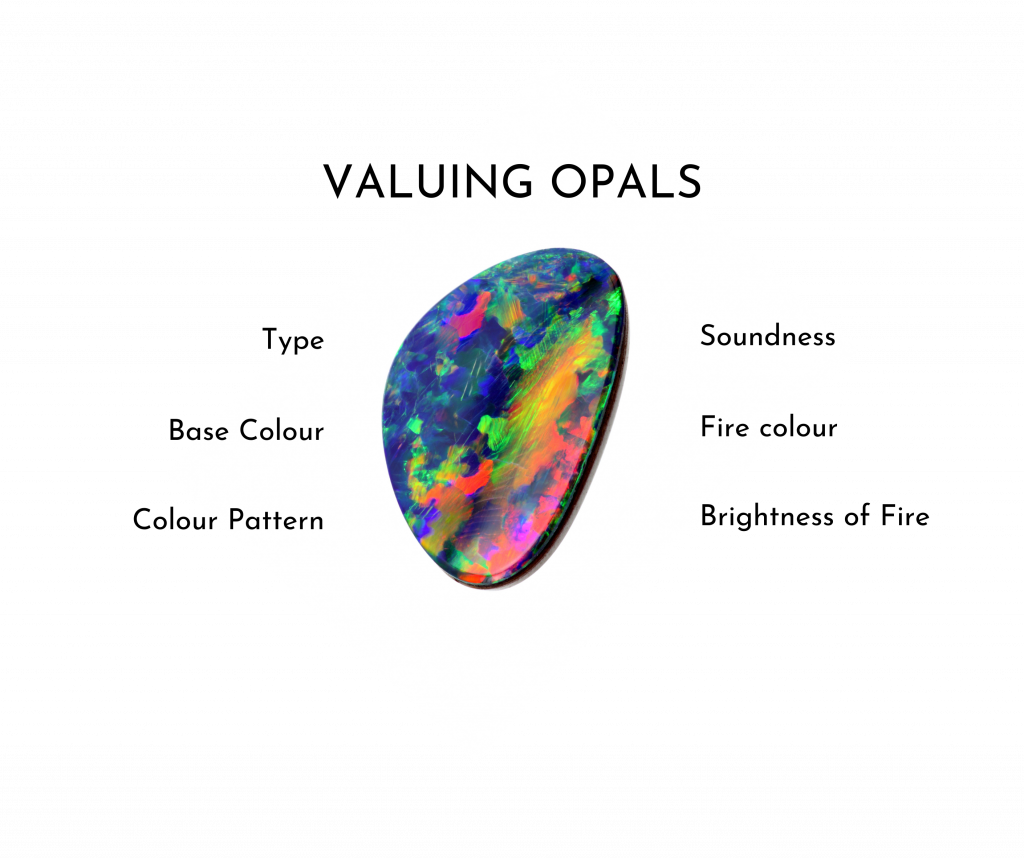
Background Colour
It is important to know the type of opal. Solid precious opal is more valuable than doublet or triplet opals. Black opal is more valuable than boulder opal, which in turn tends to be more valuable than light opal. The darker the body colour, the more valuable the gem.
The clarity of the colour is critical when assessing the value of opal. Red fire is the rarest colour, followed by green/orange, green/blue, and blue. Therefore, red fire opal is generally more valuable than a predominantly green opal, which in turn is more valuable than a stone showing only blue colour.
However, brilliance and clarity of an open proportioned pattern are the main decision-makers – a brilliant blue/green can cost more than a dull red; bright twinkling stars of a’pinfire’ pattern can cost more than a cloudy open pattern of similar colouration; or a brilliant, lustrous light opal can cost more than a lacklustre black opal.
Colour Pattern
Almost all opal displays some form of pattern. You will never find two opals that are the same. In particular, many of the top-quality pieces of black opal from Lightning Ridge show their strength through a distinct recognisable pattern play of strong colours. Some of the various patterns are listed below.
- Harlequin Pattern is the most prized of all patterns and is very rare. The colours in this pattern are more or less arranged like checkerboard squares.
- Floral Pattern is possibly the most common of all nice patterns and its name is derived from its likeness to floral dress material. This pattern covers a broad range of design and colour.
- Pinfire Pattern closely resembles a mass of pinheads in different colours.
- Palette Pattern is like an artist’s palette.
- Mobile Rolling Flash usually consists of one colour that travels across part or all of the stone as it is moved.
Soundness
Opal should be free from cracks and flaws.
CARING FOR YOUR OPALS

Opals are softer and more fragile than most crystalline gems. As with all precious items, a certain amount of care should be taken. Be careful not to scratch or hit opals, especially those mounted in rings. Also avoid wearing an opal ring while washing up, gardening or doing the housework.

Opals are composed of between three and 20 per cent water and as such, they should not be allowed to freeze or dry out. In the case of solid opal, an occasional light rinsing in fresh water is recommended. However, never immerse a triplet or doublet opal in water for any reason whatsoever because such an action may cause permanent damage.

When storing opals, avoid plastic bags and dry storage conditions. Soft cloth bags with padding are ideal for opals. If storing a solid opal, take it out for an occasional wipe with a damp cloth or a dip in fresh water. Use a soft dry cloth to clean opals. With care, opals may be enjoyed for many years to come.

The showcases at Costello’s displaying solid opal also carry small glasses of water. As mentioned earlier, opal contains water: spending time in the enclosed space of the display case under the heat of the overhead spotlights can make an opal thirsty! Therefore, a container of water helps the opal retain this moisture by creating a humid atmosphere in the showcase.

